Multi-Scale Digital Image Correlation Analysis of In Situ Deformation of Open-Cell Porous Ultra-High Molecular Weight Polyethylene Foam
Abstract
1. Introduction
2. Materials and Methods
2.1. Porous UHMWPE Sample Preparation
2.2. X-Ray Tomography
2.3. Two- and Three-Dimensional Structure Characterization
2.4. In Situ Compression Test
2.5. DIC Analysis
3. Results and Discussion
3.1. Two- and Three-Dimensional Structure Characterisation
- (1)
- 3D objects certainly have higher values than 2D due to their geometry and location related to the 2D slice;
- (2)
- Segmentation tools are not robust, and strictly depend on the chosen thresholding value in general.
3.2. Ashby and Gibson Model
3.3. Macro Strain Analysis
3.4. Micro Strain Analysis
3.5. Comparison of DIC Results to Experimental Data
4. Conclusions
Author Contributions
Funding
Acknowledgments
Conflicts of Interest
Appendix A

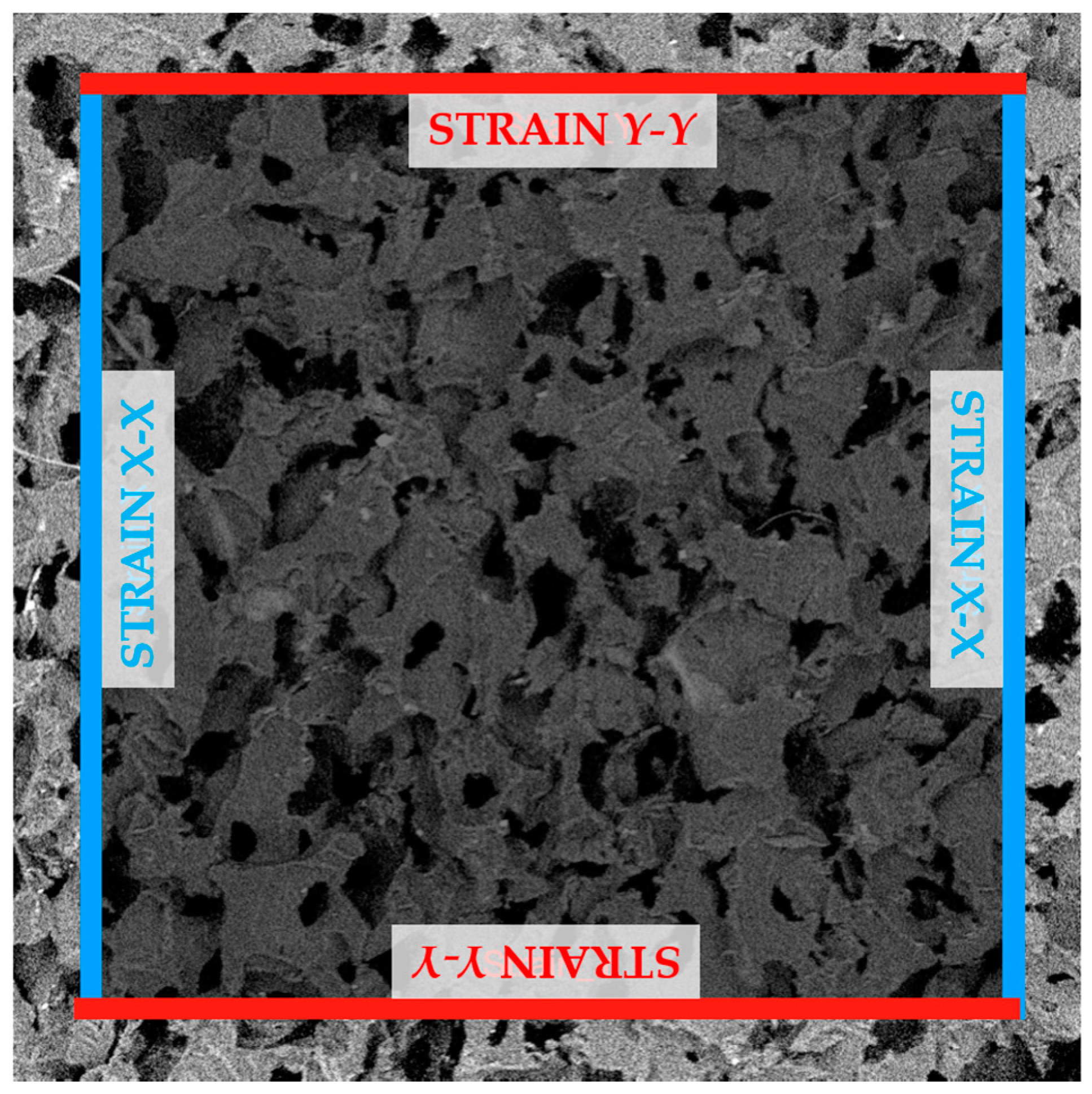
References
- Scopus Database [Electronic Resource]. Available online: www.scopus.com (accessed on 1 September 2020).
- Zherebtsov, D.; Chukov, D.; Statnik, E.S.; Torokhov, V. Hybrid self-reinforced composite materials based on ultra-high molecular weight polyethylene. Materials 2020, 13, 1739. [Google Scholar]
- Zherebtsov, D.; Chukov, D.; Torokhov, V.; Statnik, E.S. Manufacturing of single-polymer composite materials based on ultra-high molecular weight polyethylene fibers by hot compaction. J. Mater. Eng. Perform. 2020, 29, 1522–1527. [Google Scholar]
- Maksimkin, A.V.; Senatov, F.S.; Niaza, K.; Dayyoub, T.; Kaloshkin, S.D. Ultra-high molecular weight polyethylene/titanium-hybrid implant for bone-defect replacement. Materials 2020, 13, 3010. [Google Scholar] [CrossRef] [PubMed]
- Senatov, F.; Chubrik, A.; Maksimkin, A.; Kolesnikov, E.; Salimon, A.I. Comparative analysis of structure and mechanical properties of porous PEEK and UHMWPE biomimetic scaffolds. Mater. Lett. 2018, 239, 63–66. [Google Scholar] [CrossRef]
- Kan, Y.; Cvjetinovic, J.; Statnik, E.S.; Ryazantsev, S.V.; Anisimova, N.Y.; Kiselevskiy, M.V.; Salimon, A.I.; Maksimkin, A.V.; Korsunsky, A.M. The fabrication and characterization of bioengineered ultra-high molecular weight polyethylene-collagen-hap hybrid bone-cartilage patch. Mater. Today Commun. 2020, 24, 101052. [Google Scholar] [CrossRef]
- Sui, T.; Salvati, E.; Zhang, H.; Nyaza, K.; Senatov, F.S.; Salimon, A.I.; Korsunsky, A.M. Probing the complex thermo-mechanical properties of a 3D-printed polylactide-hydroxyapatite composite using in situ synchrotron X-ray scattering. J. Adv. Res. 2018, 16, 113–122. [Google Scholar] [CrossRef] [PubMed]
- Maksimkin, A.V.; Senatov, F.S.; Anisimova, N.Y.; Kiselevskiy, M.V.; Zalepugin, D.; Chernyshova, I.; Tilkunova, N.; Kaloshkin, S.D. Multilayer porous UHMWPE scaffolds for bone defects replacement. Mater. Sci. Eng. C 2017, 73, 366–372. [Google Scholar] [CrossRef] [PubMed]
- Kan, Y.; Cvjetinovic, J.; Salimon, A.I.; Statnik, E.S.; Ryazantsev, S.V.; Korsunsky, A.M. Collagen-based Composite and Hybrid Bone Implant Materials: Structure and Property Characterization. In Lecture Notes in Engineering and Computer Science: Proceedings of the World Congress on Engineering 2019, London, UK, 3–5 July 2019; Ao, S.I., Gelman, L., Eds.; Newswood Limited: Hong Kong, 2019; pp. 356–364. [Google Scholar]
- Lermontov, S.A.; Maksimkin, A.V.; Sipyagina, N.A.; Malkova, A.N.; Kolesnikov, E.A.; Zadorozhnyy, M.Y.; Straumal, E.A.; Dayyoub, T. Ultra-high molecular weight polyethylene with hybrid porous structure. Polymer 2020, 202, 122744. [Google Scholar] [CrossRef]
- Ustyugov, A.; Chicheva, M.; Lysikova, E.; Vikhareva, E.; Sipyagina, N.; Malkova, A.; Straumal, E.; Bovina, E.; Senatov, F.S.; Salimon, A.I.; et al. Development of 3D cell culture on ultra-high molecular weight polyethylene (UHMWPE) as the basis of cellular matrix. Biomed. Chem. Res. Methods 2018, 1, e00048. [Google Scholar] [CrossRef]
- Salimon, A.I.; Statnik, E.S.; Zadorozhnyy, M.Y.; Senatov, F.S.; Zherebtsov, D.D.; Safonov, A.A.; Korsunsky, A.M. Porous open-cell UHMWPE: Experimental study of structure and mechanical properties. Materials 2019, 12, 2195. [Google Scholar] [CrossRef]
- Gibson, L.; Ashby, M. Cellular Solids: Structure and Properties; Cambridge University Press: Cambridge, UK, 1997. [Google Scholar]
- ISO 9001:2008 [Electronic Resource]. Available online: www.iso.org (accessed on 1 September 2020).
- ImageJ [Electronic Resource]. Available online: www.imagej.nih.gov/ij/ (accessed on 1 September 2020).
- Thermo Fisher Scientific. User’s Guide Avizo Software 2019; Konrad-Zuse-Zentrum fur Informationstechnik: Berlin (ZIB), Germany, 2019. [Google Scholar]
- Hildebrand, T.; Rüegsegger, P. A new method for the model-independent assessment of thickness in three-dimensional images. J. Microsc. 1997, 185, 67–75. [Google Scholar] [CrossRef]
- ASTM D1621-16 [Electronic Resource]. Available online: www.https://doi.org/10.1520/D1621-16 (accessed on 1 September 2020).
- Blaber, J.; Adair, B.; Antoniou, A. Ncorr: Open-source 2D Digital Image Correlation Matlab software. Exp. Mech. 2015, 55, 1105–1122. [Google Scholar] [CrossRef]
- Gibson, L.J.; Ashby, M.F. The mechanics of three-dimensional cellular materials. Proc. R. Soc. Lond. Ser. Math. Phys. Sci. 1982, 382, 43–59. [Google Scholar]
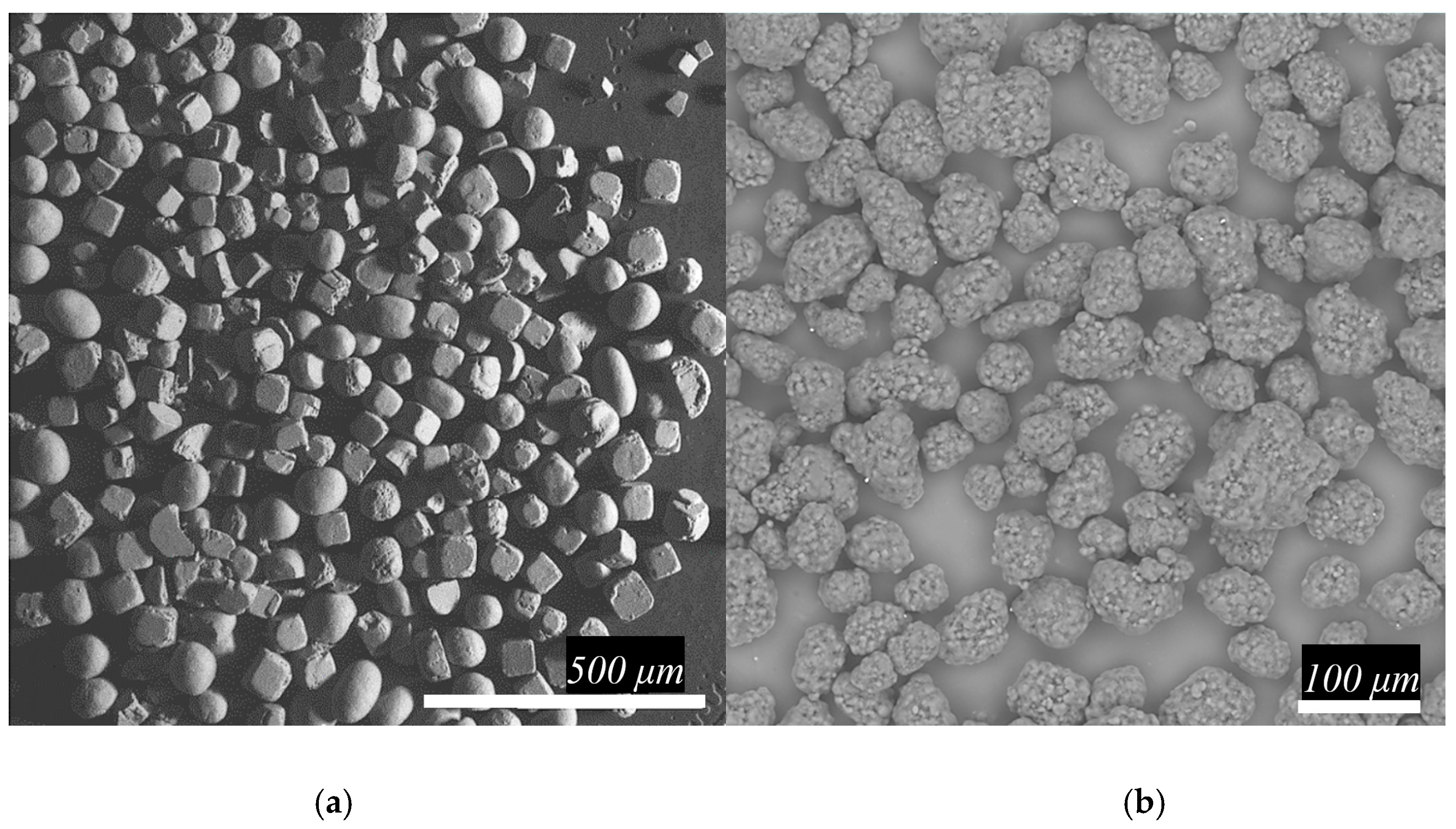
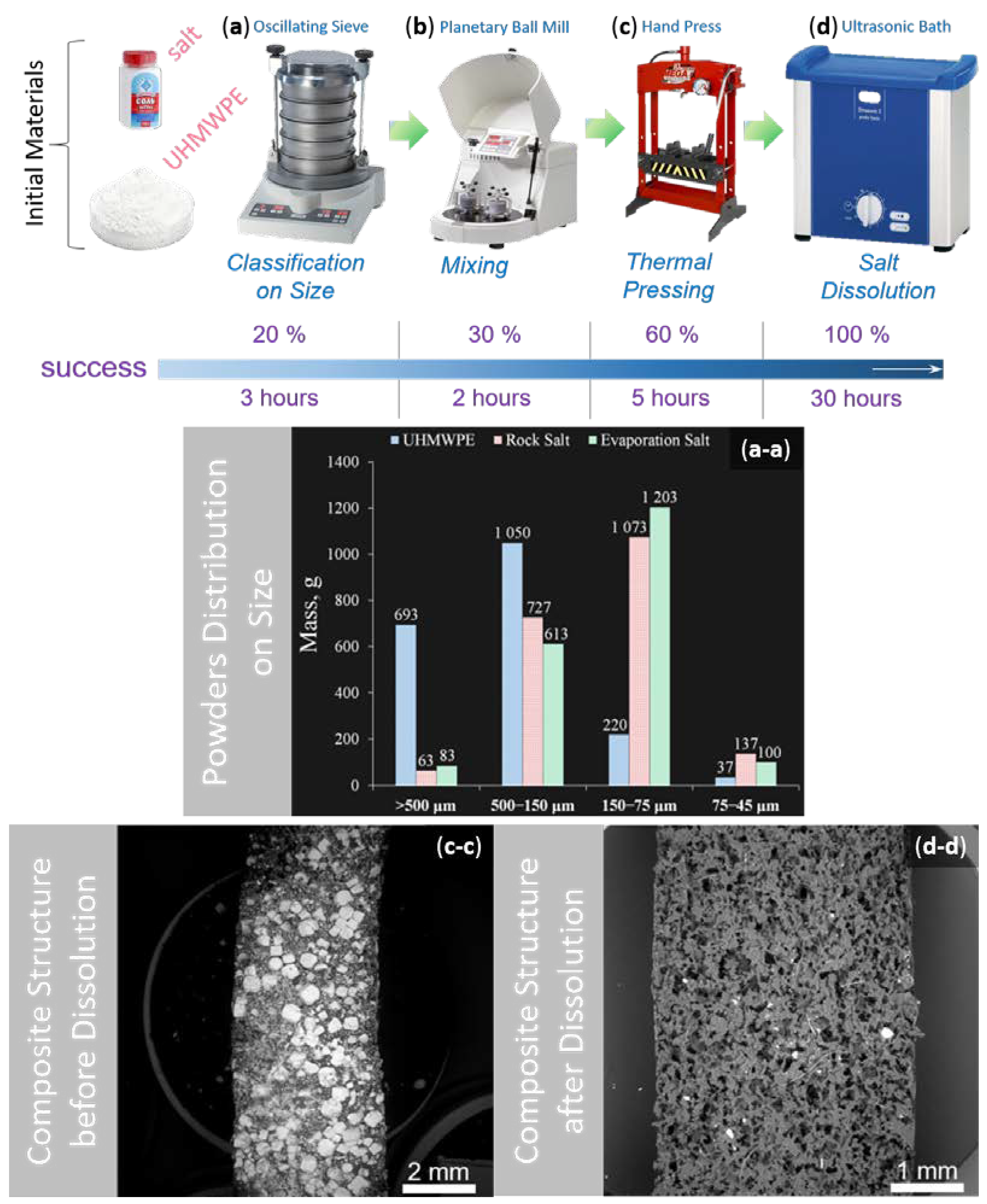

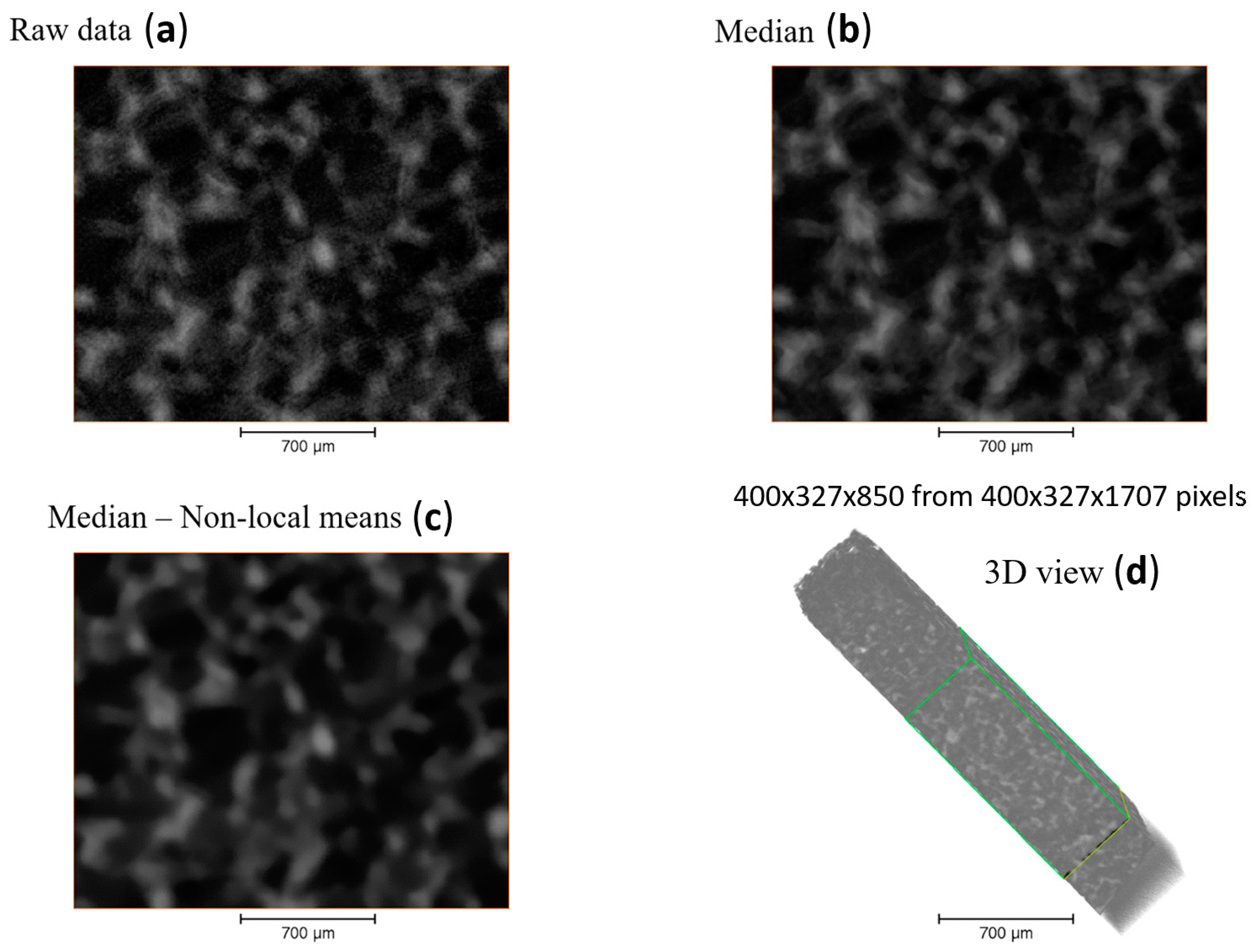
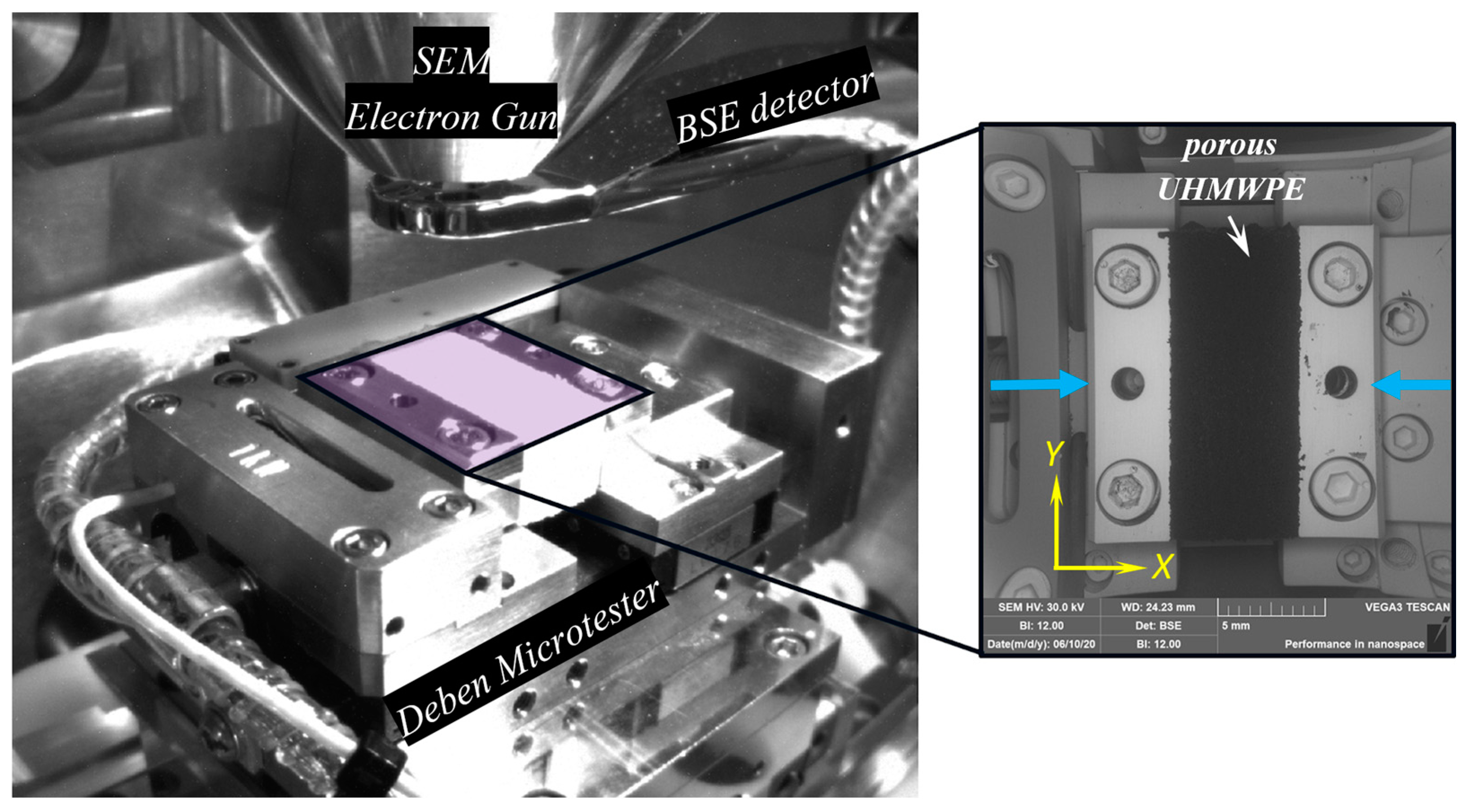
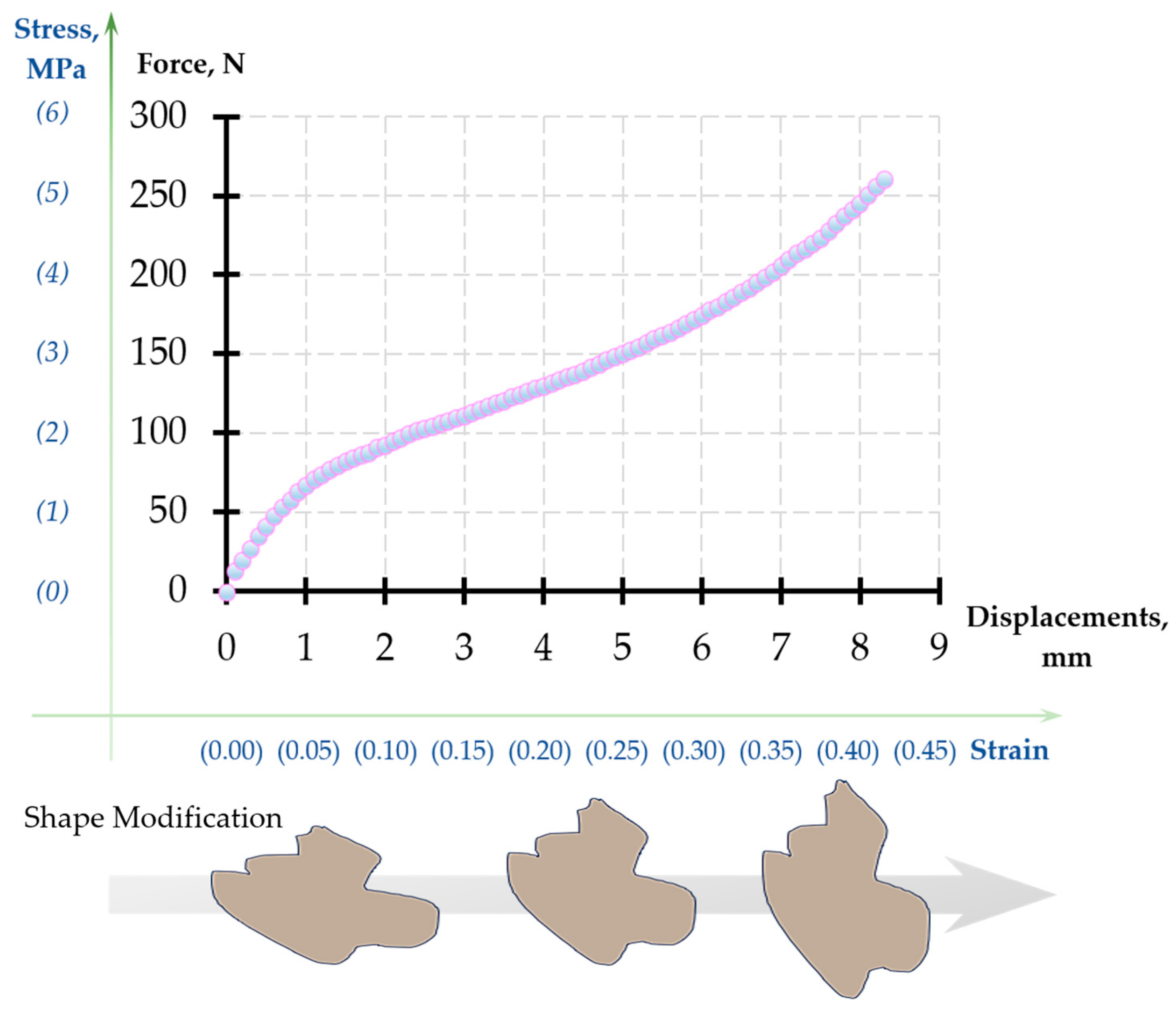
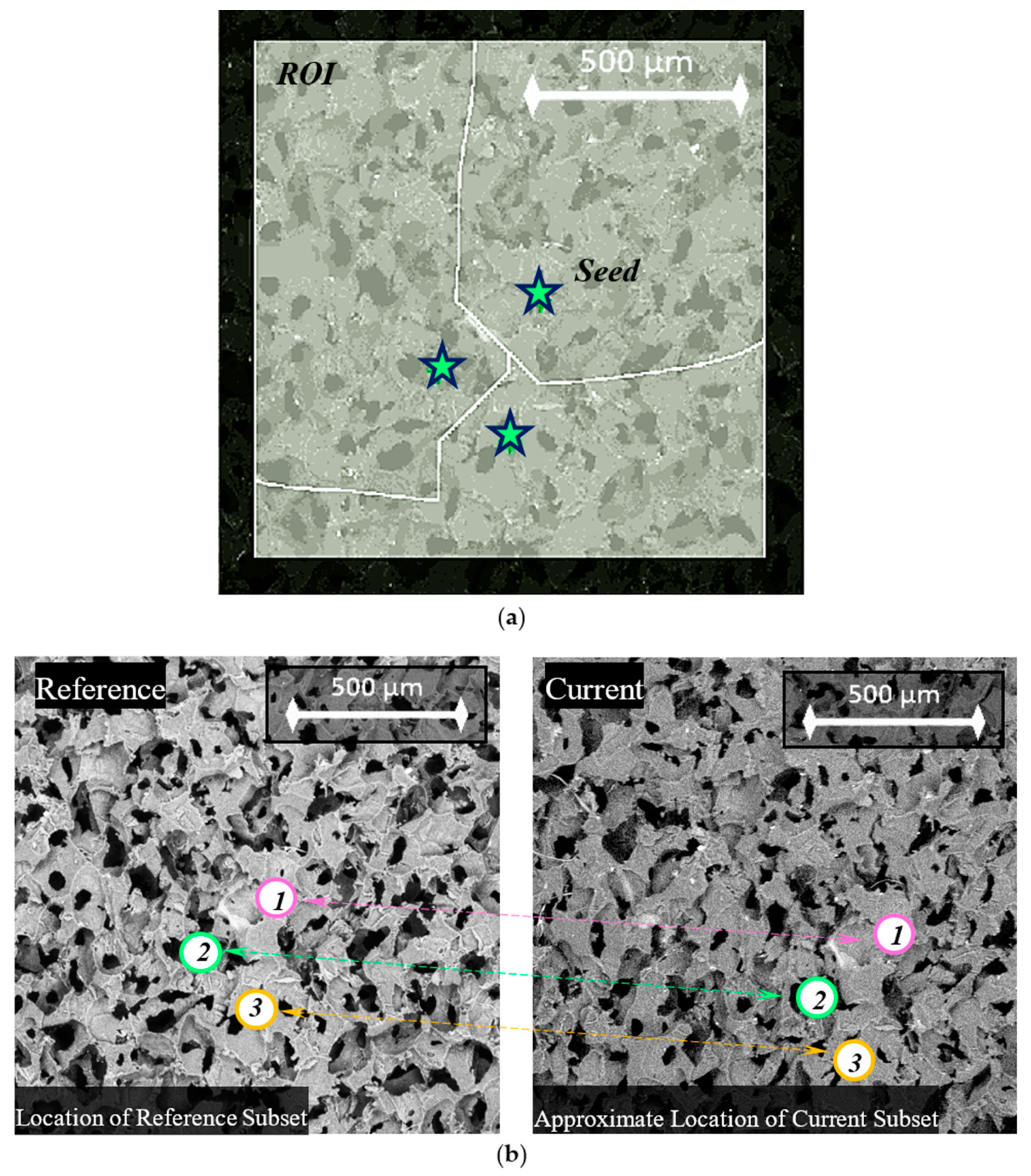
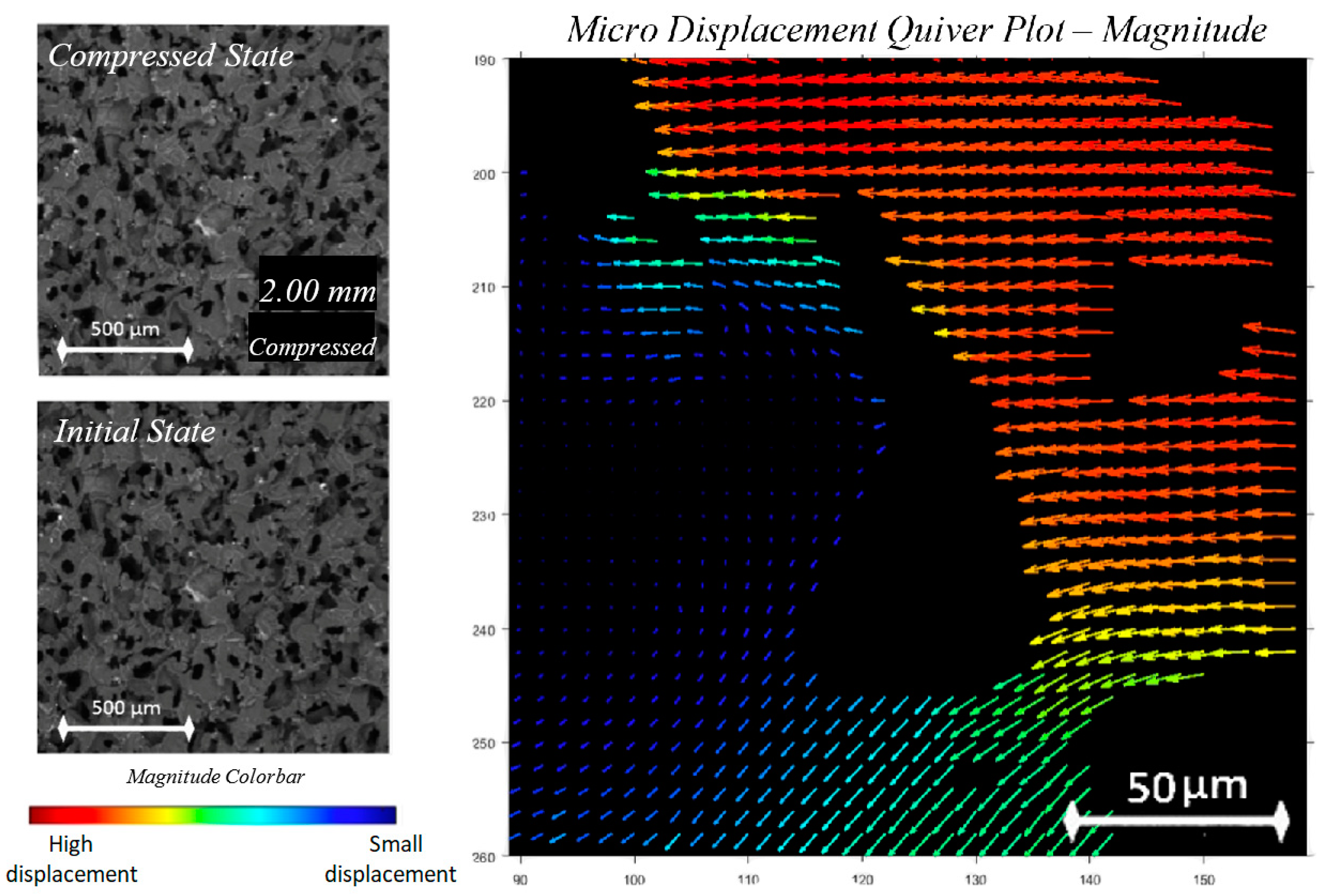
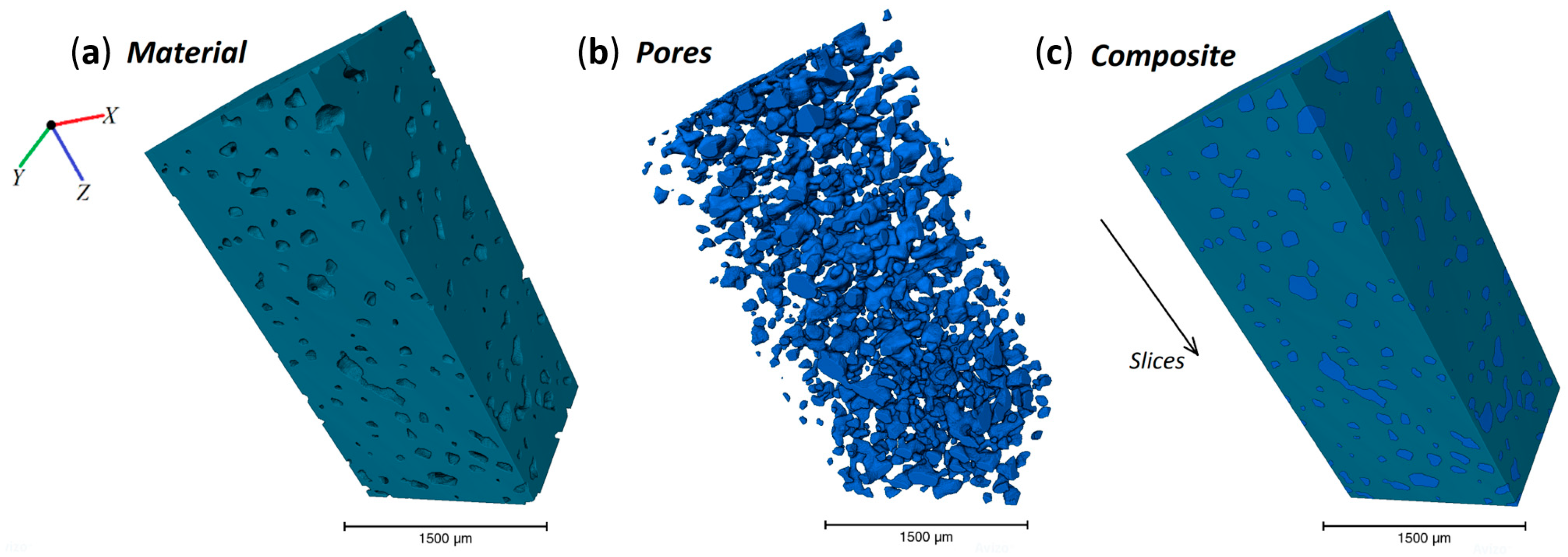
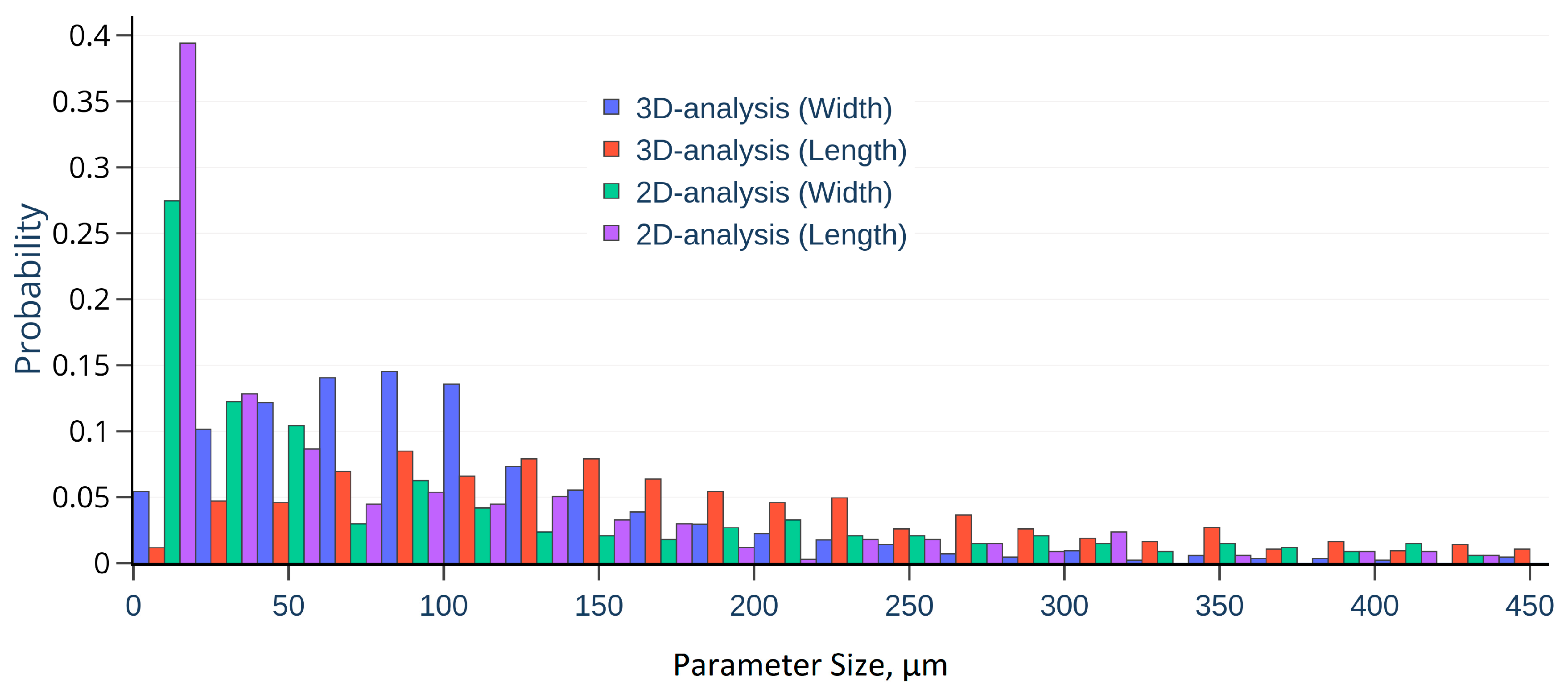




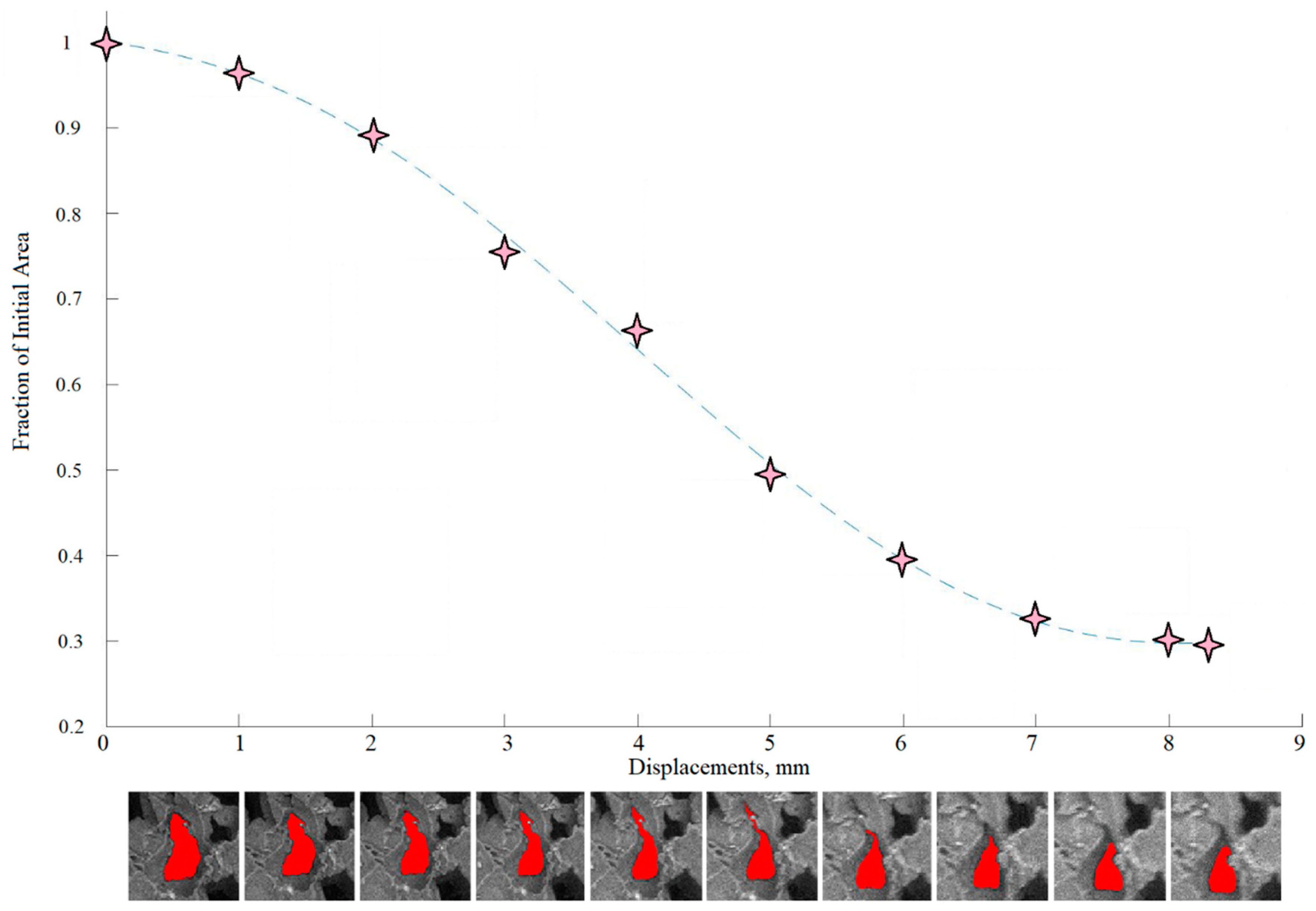
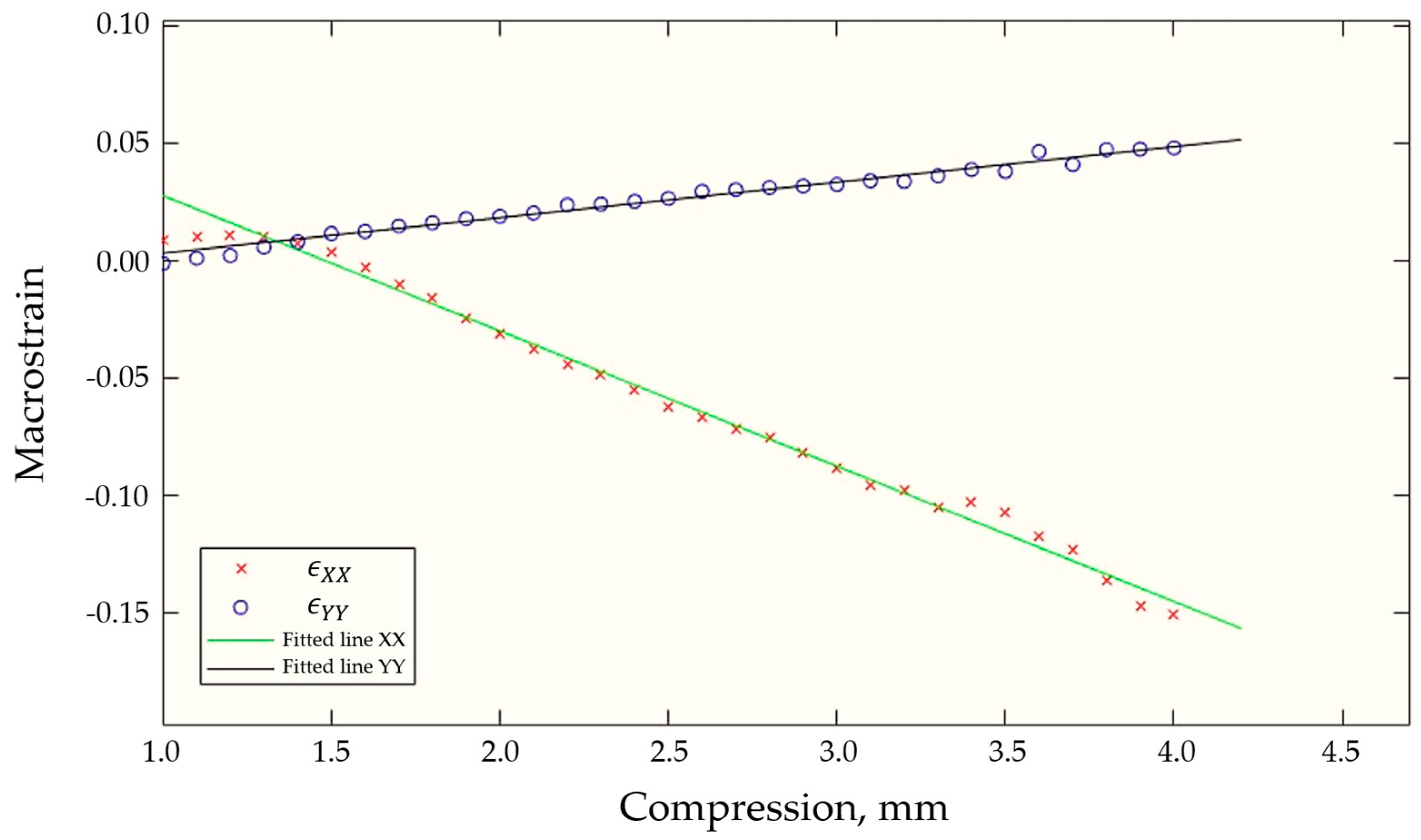
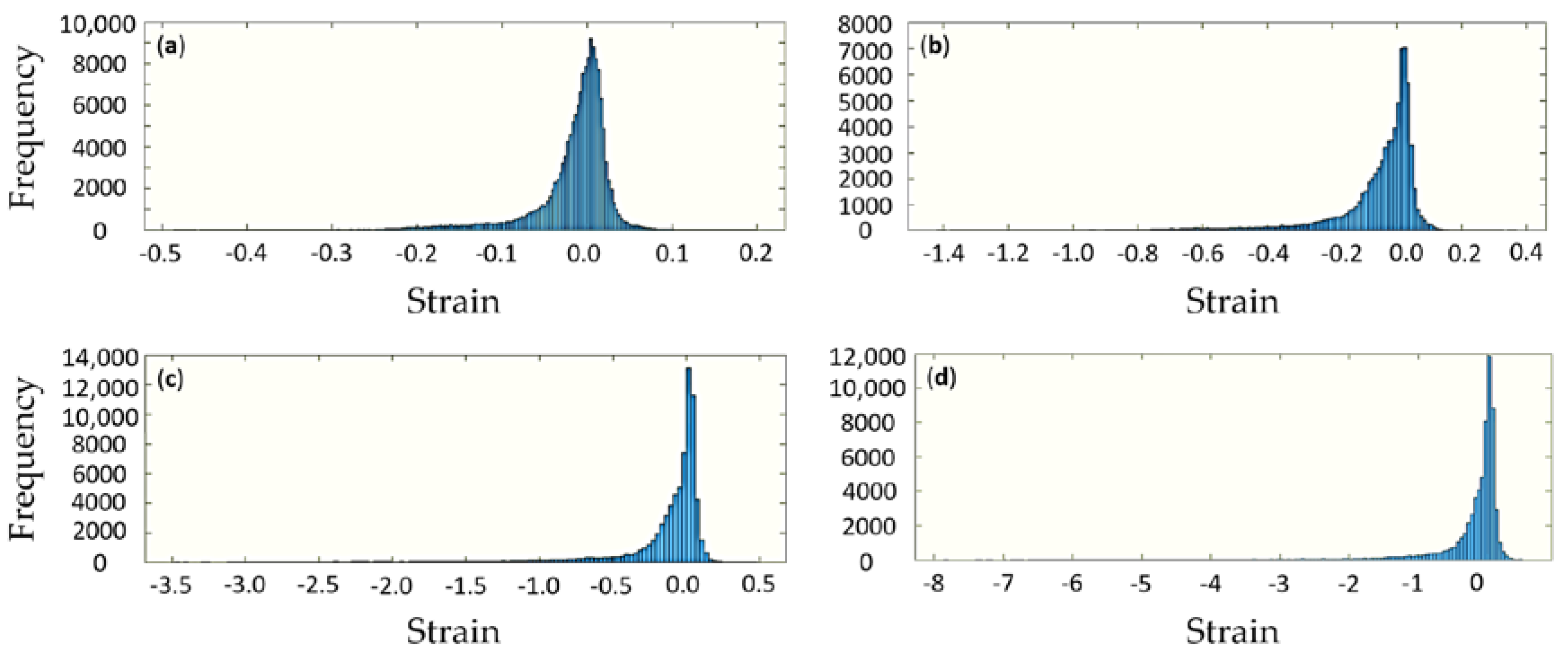
Publisher’s Note: MDPI stays neutral with regard to jurisdictional claims in published maps and institutional affiliations. |
© 2020 by the authors. Licensee MDPI, Basel, Switzerland. This article is an open access article distributed under the terms and conditions of the Creative Commons Attribution (CC BY) license (http://creativecommons.org/licenses/by/4.0/).
Share and Cite
Statnik, E.S.; Dragu, C.; Besnard, C.; Lunt, A.J.G.; Salimon, A.I.; Maksimkin, A.; Korsunsky, A.M. Multi-Scale Digital Image Correlation Analysis of In Situ Deformation of Open-Cell Porous Ultra-High Molecular Weight Polyethylene Foam. Polymers 2020, 12, 2607. https://doi.org/10.3390/polym12112607
Statnik ES, Dragu C, Besnard C, Lunt AJG, Salimon AI, Maksimkin A, Korsunsky AM. Multi-Scale Digital Image Correlation Analysis of In Situ Deformation of Open-Cell Porous Ultra-High Molecular Weight Polyethylene Foam. Polymers. 2020; 12(11):2607. https://doi.org/10.3390/polym12112607
Chicago/Turabian StyleStatnik, Eugene S., Codrutza Dragu, Cyril Besnard, Alexander J.G. Lunt, Alexey I. Salimon, Aleksey Maksimkin, and Alexander M. Korsunsky. 2020. "Multi-Scale Digital Image Correlation Analysis of In Situ Deformation of Open-Cell Porous Ultra-High Molecular Weight Polyethylene Foam" Polymers 12, no. 11: 2607. https://doi.org/10.3390/polym12112607
APA StyleStatnik, E. S., Dragu, C., Besnard, C., Lunt, A. J. G., Salimon, A. I., Maksimkin, A., & Korsunsky, A. M. (2020). Multi-Scale Digital Image Correlation Analysis of In Situ Deformation of Open-Cell Porous Ultra-High Molecular Weight Polyethylene Foam. Polymers, 12(11), 2607. https://doi.org/10.3390/polym12112607









